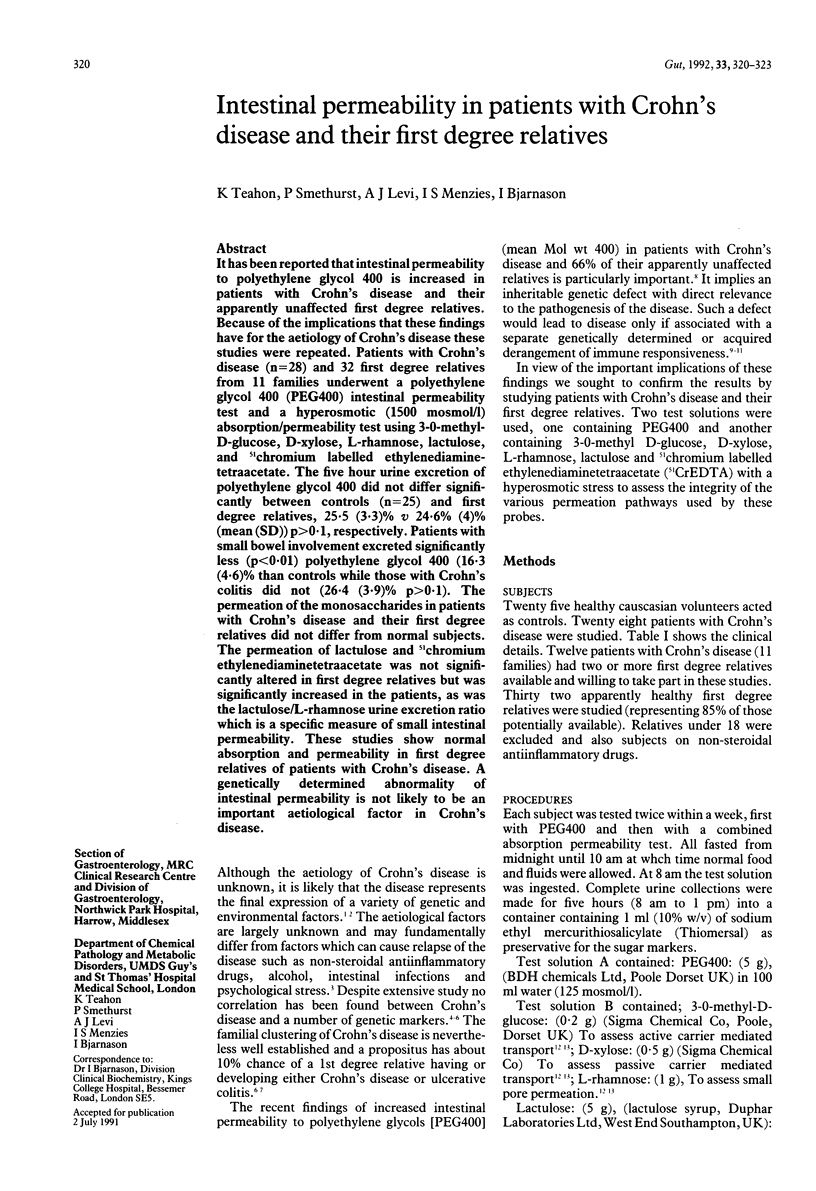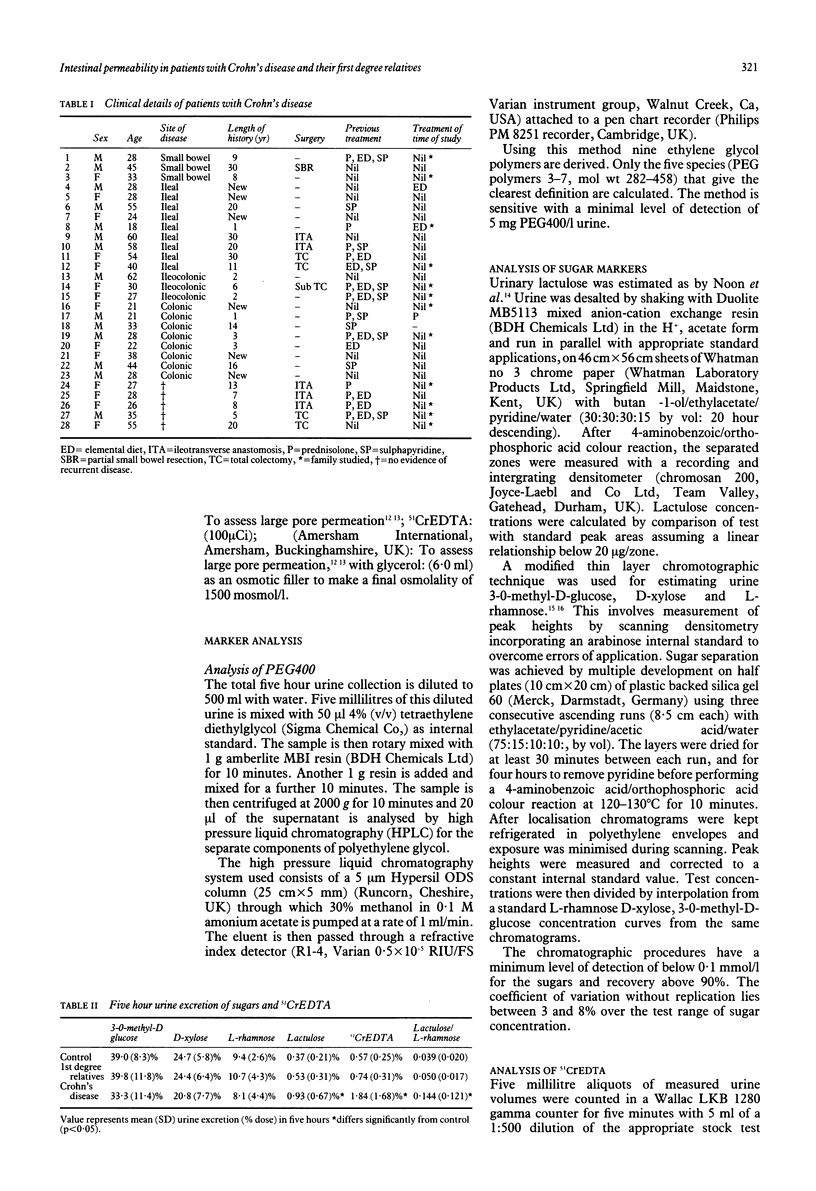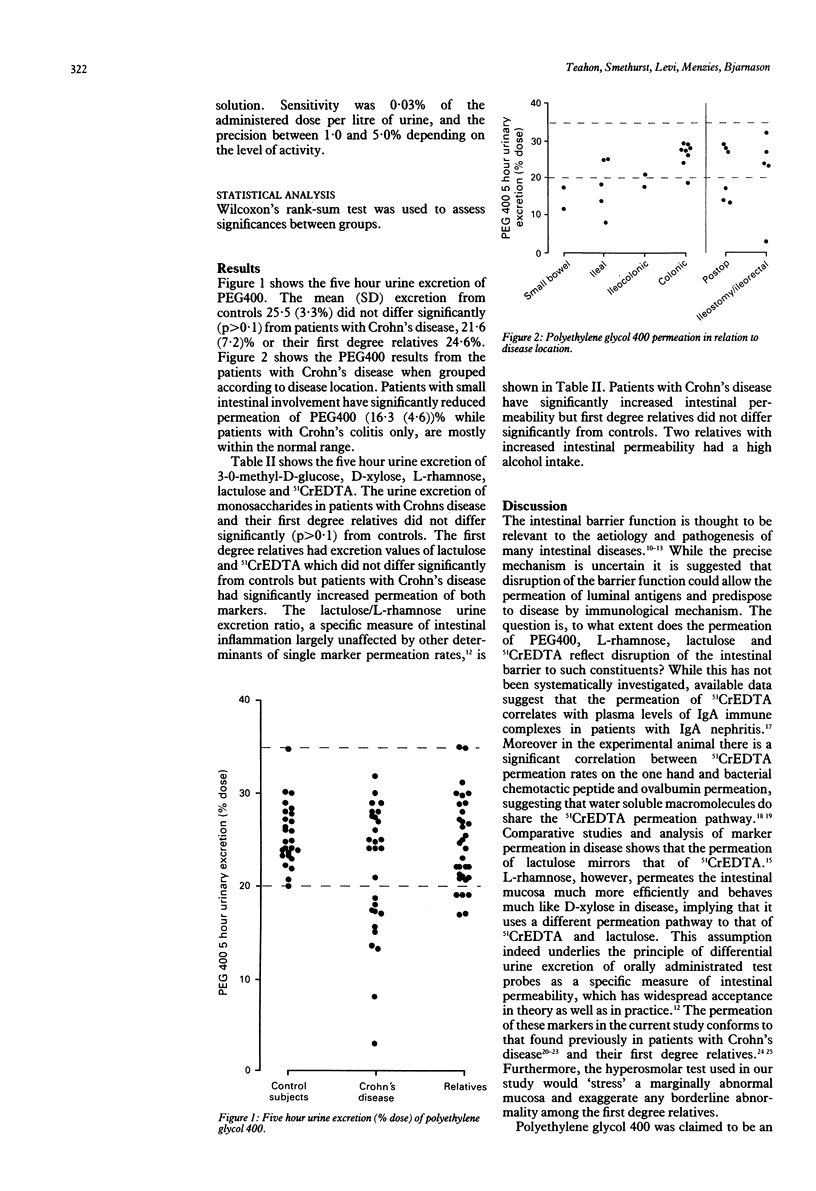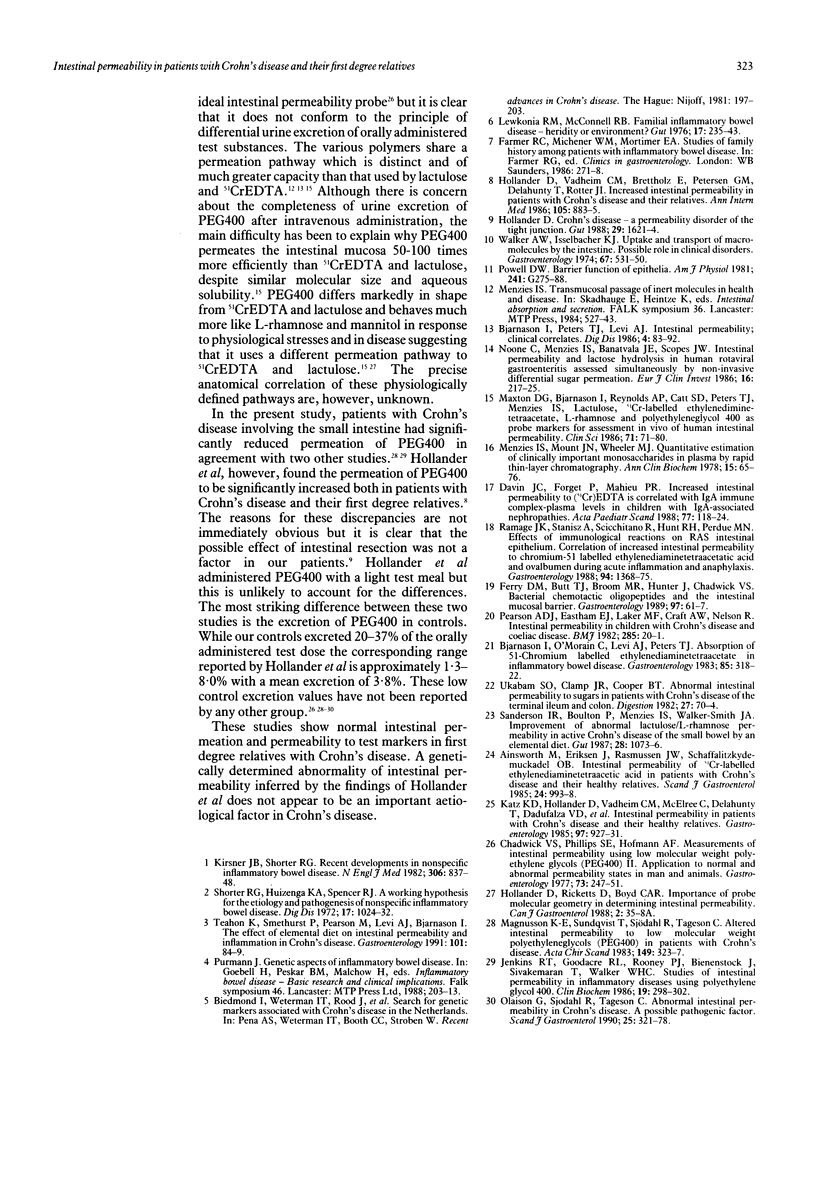Abstract
It has been reported that intestinal permeability to polyethylene glycol 400 is increased in patients with Crohn's disease and their apparently unaffected first degree relatives. Because of the implications that these findings have for the aetiology of Crohn's disease these studies were repeated. Patients with Crohn's disease (n = 28) and 32 first degree relatives from 11 families underwent a polyethylene glycol 400 (PEG400) intestinal permeability test and a hyperosmotic (1500 mosmol/l) absorption/permeability test using 3-0-methyl-D-glucose, D-xylose, L-rhamnose, lactulose, and 51chromium labelled ethylenediamine-tetraacetate. The five hour urine excretion of polyethylene glycol 400 did not differ significantly between controls (n = 25) and first degree relatives, 25.5 (3.3)% v 24.6% (4)% (mean(SD)) p greater than 0.1, respectively. Patients with small bowel involvement excreted significantly less (p less than 0.01) polyethylene glycol 400 (16.3 (4.6)% than controls while those with Crohn's colitis did not (26.4 (3.9)% p greater than 0.1). The permeation of the monosaccharides in patients with Crohn's disease and their first degree relatives did not differ from normal subjects. The permeation of lactulose and 51chromium ethylenediaminetetraacetate was not significantly altered in first degree relatives but was significantly increased in the patients, as was the lactulose/L-rhamnose urine excretion ratio which is a specific measure of small intestinal permeability. These studies show normal absorption and permeability in first degree relatives of patients with Crohn's disease. A genetically determined abnormality of intestinal permeability is not likely to be an important aetiological factor in Crohn's disease.
Full text
PDF



Selected References
These references are in PubMed. This may not be the complete list of references from this article.
- Ainsworth M., Eriksen J., Rasmussen J. W., Schaffalitzky de Muckadell O. B. Intestinal permeability of 51Cr-labelled ethylenediaminetetraacetic acid in patients with Crohn's disease and their healthy relatives. Scand J Gastroenterol. 1989 Oct;24(8):993–998. doi: 10.3109/00365528909089246. [DOI] [PubMed] [Google Scholar]
- Bjarnason I., O'Morain C., Levi A. J., Peters T. J. Absorption of 51chromium-labeled ethylenediaminetetraacetate in inflammatory bowel disease. Gastroenterology. 1983 Aug;85(2):318–322. [PubMed] [Google Scholar]
- Bjarnason I., Peters T. J., Levi A. J. Intestinal permeability: clinical correlates. Dig Dis. 1986;4(2):83–92. doi: 10.1159/000171140. [DOI] [PubMed] [Google Scholar]
- Chadwick V. S., Phillips S. F., Hofmann A. F. Measurements of intestinal permeability using low molecular weight polyethylene glycols (PEG 400). II. Application to normal and abnormal permeability states in man and animals. Gastroenterology. 1977 Aug;73(2):247–251. [PubMed] [Google Scholar]
- Davin J. C., Forget P., Mahieu P. R. Increased intestinal permeability to (51 Cr) EDTA is correlated with IgA immune complex-plasma levels in children with IgA-associated nephropathies. Acta Paediatr Scand. 1988 Jan;77(1):118–124. doi: 10.1111/j.1651-2227.1988.tb10609.x. [DOI] [PubMed] [Google Scholar]
- Ferry D. M., Butt T. J., Broom M. F., Hunter J., Chadwick V. S. Bacterial chemotactic oligopeptides and the intestinal mucosal barrier. Gastroenterology. 1989 Jul;97(1):61–67. doi: 10.1016/0016-5085(89)91416-9. [DOI] [PubMed] [Google Scholar]
- Hollander D. Crohn's disease--a permeability disorder of the tight junction? Gut. 1988 Dec;29(12):1621–1624. doi: 10.1136/gut.29.12.1621. [DOI] [PMC free article] [PubMed] [Google Scholar]
- Hollander D., Vadheim C. M., Brettholz E., Petersen G. M., Delahunty T., Rotter J. I. Increased intestinal permeability in patients with Crohn's disease and their relatives. A possible etiologic factor. Ann Intern Med. 1986 Dec;105(6):883–885. doi: 10.7326/0003-4819-105-6-883. [DOI] [PubMed] [Google Scholar]
- Jenkins R. T., Goodacre R. L., Rooney P. J., Bienenstock J., Sivakumaran T., Walker W. H. Studies of intestinal permeability in inflammatory diseases using polyethylene glycol 400. Clin Biochem. 1986 Oct;19(5):298–302. doi: 10.1016/s0009-9120(86)80045-5. [DOI] [PubMed] [Google Scholar]
- Katz K. D., Hollander D., Vadheim C. M., McElree C., Delahunty T., Dadufalza V. D., Krugliak P., Rotter J. I. Intestinal permeability in patients with Crohn's disease and their healthy relatives. Gastroenterology. 1989 Oct;97(4):927–931. doi: 10.1016/0016-5085(89)91499-6. [DOI] [PubMed] [Google Scholar]
- Kirsner J. B., Shorter R. G. Recent developments in nonspecific inflammatory bowel disease (second of two parts). N Engl J Med. 1982 Apr 8;306(14):837–848. doi: 10.1056/NEJM198204083061404. [DOI] [PubMed] [Google Scholar]
- Lewkonia R. M., McConnell R. B. Progress report. Familial inflammatory bowel disease--heredity or environment? Gut. 1976 Mar;17(3):235–243. doi: 10.1136/gut.17.3.235. [DOI] [PMC free article] [PubMed] [Google Scholar]
- Magnusson K. E., Sundqvist T., Sjödahl R., Tagesson C. Altered intestinal permeability to low-molecular-weight polyethyleneglycols (PEG 400) in patients with Crohn's disease. Acta Chir Scand. 1983;149(3):323–327. [PubMed] [Google Scholar]
- Maxton D. G., Bjarnason I., Reynolds A. P., Catt S. D., Peters T. J., Menzies I. S. Lactulose, 51Cr-labelled ethylenediaminetetra-acetate, L-rhamnose and polyethyleneglycol 400 [corrected] as probe markers for assessment in vivo of human intestinal permeability. Clin Sci (Lond) 1986 Jul;71(1):71–80. doi: 10.1042/cs0710071. [DOI] [PubMed] [Google Scholar]
- Menzies I. S., Mount J. N., Wheeler M. J. Quantitative estimation of clinically important monosaccharides in plasma by rapid thin layer chromatography. Ann Clin Biochem. 1978 Mar;15(2):65–76. doi: 10.1177/000456327801500116. [DOI] [PubMed] [Google Scholar]
- Pearson A. D., Eastham E. J., Laker M. F., Craft A. W., Nelson R. Intestinal permeability in children with Crohn's disease and coeliac disease. Br Med J (Clin Res Ed) 1982 Jul 3;285(6334):20–21. doi: 10.1136/bmj.285.6334.20. [DOI] [PMC free article] [PubMed] [Google Scholar]
- Powell D. W. Barrier function of epithelia. Am J Physiol. 1981 Oct;241(4):G275–G288. doi: 10.1152/ajpgi.1981.241.4.G275. [DOI] [PubMed] [Google Scholar]
- Ramage J. K., Stanisz A., Scicchitano R., Hunt R. H., Perdue M. H. Effect of immunologic reactions on rat intestinal epithelium. Correlation of increased permeability to chromium 51-labeled ethylenediaminetetraacetic acid and ovalbumin during acute inflammation and anaphylaxis. Gastroenterology. 1988 Jun;94(6):1368–1375. [PubMed] [Google Scholar]
- Sanderson I. R., Boulton P., Menzies I., Walker-Smith J. A. Improvement of abnormal lactulose/rhamnose permeability in active Crohn's disease of the small bowel by an elemental diet. Gut. 1987 Sep;28(9):1073–1076. doi: 10.1136/gut.28.9.1073. [DOI] [PMC free article] [PubMed] [Google Scholar]
- Shorter R. G., Huizenga K. A., Spencer R. J. A working hypothesis for the etiology and pathogenesis of nonspecific inflammatory bowel disease. Am J Dig Dis. 1972 Nov;17(11):1024–1032. doi: 10.1007/BF02239143. [DOI] [PubMed] [Google Scholar]
- Teahon K., Smethurst P., Pearson M., Levi A. J., Bjarnason I. The effect of elemental diet on intestinal permeability and inflammation in Crohn's disease. Gastroenterology. 1991 Jul;101(1):84–89. doi: 10.1016/0016-5085(91)90463-u. [DOI] [PubMed] [Google Scholar]
- Ukabam S. O., Clamp J. R., Cooper B. T. Abnormal small intestinal permeability to sugars in patients with Crohn's disease of the terminal ileum and colon. Digestion. 1983;27(2):70–74. doi: 10.1159/000198932. [DOI] [PubMed] [Google Scholar]
- Walker W. A., Isselbacher K. J. Uptake and transport of macromolecules by the intestine. Possible role in clinical disorders. Gastroenterology. 1974 Sep;67(3):531–550. [PubMed] [Google Scholar]


